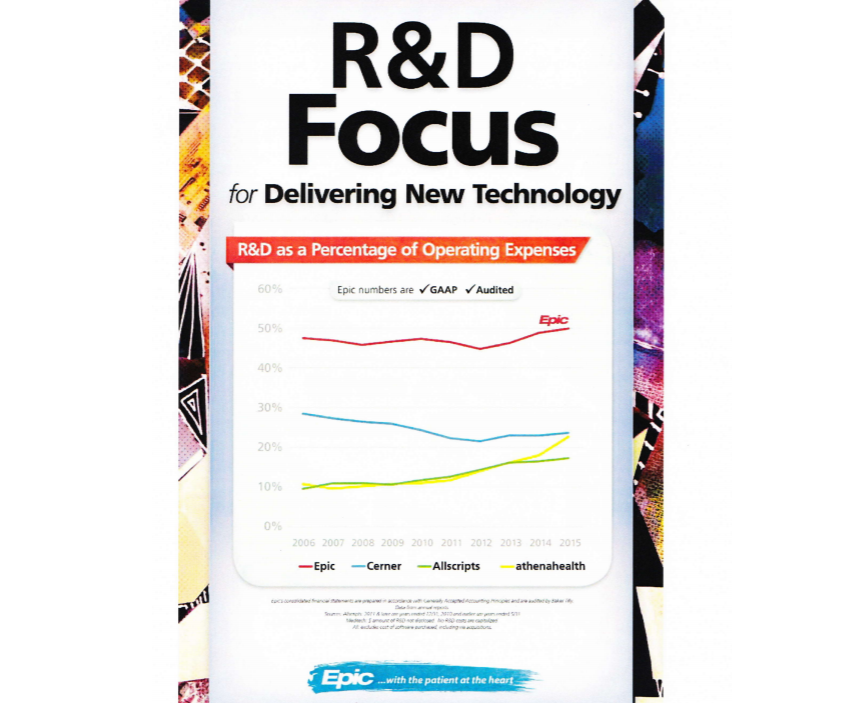
Getty Images
Judy Faulkner: Epic Is Changing the Big Data, Interoperability Game
During HIMSS17, Epic Systems founder and CEO Judy Faulkner discussed her philosophy on interoperability and announced some new big data offerings.

In the flashy, crowded, dizzyingly large vendor halls at the annual HIMSS Conference and Exhibition, attendees tend to find their way around by using some of the biggest, tallest, or most unique booths as a compass.
A left at Cerner; a right at IBM Watson Health; three city blocks down from Epic Systems, which has been one of the healthcare industry’s most notable landmarks for years.
Epic took up a lot of space at HIMSS17, even more than it used to at previous exhibitions.
Its sprawling complex was filled with whimsical art and colorful sculptures from the company’s home offices in Wisconsin, interspersed with demo stations, knots of people deep in animated conversation, and posters packed with data highlighting the financial benefits of signing on with a software company that has once again secured top bragging rights from KLAS Rankings.
And at the center of the bustling show is founder and CEO Judy Faulkner, whose eclectic interests and visible enthusiasm for her craft are infused into the company’s public face, despite the fact that she herself has a reputation for being a relatively reclusive figure.

Armed with a pile of data-heavy printouts, some strong opinions, and a long list of innovative products and initiatives on the way to the marketplace, Faulkner sat down with HealthITAnalytics.com to discuss some of the ways Epic is bringing interoperability and big data analytics to its users while simultaneously striving to make the electronic health record “a joy to use.”
“We're really hitting interoperability in a different way that's game changing,” she said. “We have information sharing capabilities at multiple levels, including interfaces and APIs.”
After a rocky few years in the court of public opinion, Epic has gone on the offensive to stress its multiple avenues for interoperability and data sharing to support population health management and increasingly accountable patient care.
Faulkner herself is concerned and a little frustrated that the healthcare community does not always see eye-to-eye with her on how open and transparent Epic can be.
This year, she chose a subtle way to create a buzz and nudge the conversation along by offering attendees free copies of Truth and the Dragon, a visual essay by Elsa Bailey that encourages readers to seek out truth despite the insidious methods for obscuring facts and twisting reality used by the “dragon distortion.”

“We got permission from the American Friends Service Committee, a Quaker organization, to make a few changes,” Faulkner said.
The booklet was originally published in 1965. One page explains how the “dragon” uses name calling and unpopular terms to discredit entities and “blur the vision” of observers.
“In the original, that page said ‘commie.’ and that doesn't really play anymore,” she said. “So for this audience here, we changed it to ‘data blocking.’ Whether you're a vendor or a healthcare organization, that term is something that definitely does play.”

“Data blocking” is certainly an evocative and contentious term, and one that featured prominently in the 21st Century Cures Act, which sets the stage for the first real penalties levied on organizations that actively withhold data.
Faulkner does not believe Epic falls into that category, but neither does she think that the vendor community has the right tools and metrics to figure out how well the industry is really doing with interoperability.
“One of the things I've wanted to see for a long time is a requirement that people report how much they do with interoperability – and that has to be true interoperability,” she said.
“Sometimes numbers come out that include interfaces, but that's not what we're talking about. We're talking about when a patient leaves Saint Regional Hospital and goes to their PCP at Health Helper and the data goes with them.”
READ: How Epic Systems is Advancing Healthcare Interoperability
A standardized metric and mandated reporting will help federal rule makers and other stakeholders figure out how best to proceed with potential demerits or additional mandates.
“Right now, it's like asking a provider how they're doing with diabetes care, and getting the answer, ‘Oh, we're doing very well,’” said Faulkner. “Okay, if you’re doing so well, then let's see your numbers and your results. I think we need to get a lot better at measuring what's really going on out there.”
Epic users have a number of different ways to make sure they’re staying on the right side of the law, she added – and that they can go well above and beyond the barebones definition of data exchange.
One of the easiest methods is through EpicCare Link, she said, a web-based viewing portal that allows organizations to quickly track their patients’ progress at another facility, get alerts, schedule appointments, and place orders.
"If you’re doing so well, then let's see your numbers and your results. I think we need to get a lot better at measuring what's really going on out there.”
Providers do not need to be using Epic, or even an EHR product with CCDA exchange capabilities. Instead, they can log in to the portal and keep tabs on individuals without an additional infrastructure investment.
“The problem with interoperability is that if an organization does not have CCDA capabilities and isn't signed up for Carequality – which would mean that their contact information is there and the legal documents have been signed – then there's really nothing you can do,” said Faulkner, who noted that EpicCare Link has been available for years and is already in use at numerous facilities.
“If we can't get them on CareEverywhere, we're going to send over EpicCare Link. Now they can follow the progress of their patients and send a collection of data over, and they can get alerts back about what's going on. They will have interoperability, and it will be possible to blanket 100 percent of the country that way.”
For more intensive data needs, users with Epic’s Caboodle enterprise data warehouse can now use Kit, a companion tool, to authorize access to approved entities for research, population health management, or clinical decision making.
“Kit is a veneer over Caboodle that takes all the data entered into Caboodle and lets authorized users access it that way instead of having to do those interfaces, CCDAs, and APIs,” Faulkner said.
“All the data is there. They can just go at it. So an organization such as Health Catalyst or Watson can go into the data and do what they're best at doing with it.”
READ: 10 Biggest United States Epic EHR Hospital Implementations
Developers that create Kit-based apps for data access or analytics can list their offerings in the Epic App Orchard, which went live recently, about a year and a half after Epic trademarked the moniker.
The App Orchard is similar to other app store setups, allowing third-party developers to offer interoperability tools and other functionalities to the user community.
“Customers and vendors can put tools into the App Orchard that they can sell or share for free, because a lot of people just want to share,” said Faulkner. “Others can pick them up, take them, and use them. It's very simple.”
Epic is also fostering third-party development through Open.epic.com, which gives innovators the tools and help desk access they need to code clinical, financial, and operational apps for patients and organizational improvement.
“We have a lot of positive feedback from vendors about Open.epic.com,” she said. “I just spoke to a third-party vendor who has an app. They opened up the site, and in eight hours they had everything they needed to know about how to connect it – and it worked. That’s a great result as far as we’re concerned.”
While these tools are important for encouraging interoperability across a rapidly changing industry, connecting disparate organizations is just the first step towards a larger goal for Epic, said Faulkner.
The company is prepping to give providers and researchers access to the collected experiences of its vast array of customers through a big data repository called Cosmos.
“Cosmos will be coming out in June or July,” she said. “It'll have almost 200 million patients in it, if everyone contributes their data. Anyone who contributes to it can also take from it.”
Even if only a small proportion of Epic customers participate, the system will likely become one of the largest patient data repositories around, allowing users to engage in research and harness advanced clinical decision support capabilities.
“When Cosmos comes out, it'll be ready for research purposes,” Faulkner explained. “I truly believe that dangerous things like thalidomide would have been caught earlier had there been Cosmos at the time.”
Two other features will encourage collaboration and provide decision support for clinicians, she continued. One is called Look-Alikes.
“If I'm a physician and I have a patient in front of me that has a really strange combination of symptoms that I've never seen before and don't know how to treat, Cosmos can find other similar patients among all those millions and connect the caregivers so they can work together to find the best way forward for those individuals.”
READ: The Difference Between Big Data and Smart Data in Healthcare
The last functionality, called Best Care, will let clinicians access historical results based on the experiences of thousands of individuals.
“I could be seeing a patient who has a couple of different options for surgery, perhaps a few different medications, or some alternate therapies,” she said.
“But what's best? Cosmos will look at the patient and say, ‘Okay, 18,000 times, this was done, and here are the results. This other method was tried 22,000 times, and here are those results.’ Then the clinician can exercise his or her judgment about what would be better for the person in front of them.”
The conversation ended with Faulkner flipping through a pair of packets featuring charts and graphs about Epic’s industry ratings, customer successes, loyalty rates, and financial security metrics, taking time to break down each one in detail.
The point of the data, she concluded, was to slay the dragon of deception and give the industry some real facts to work with as providers continue to make hard decisions about optimization, replacement, and infrastructure development.
Choosing a company with a commitment to customer care and continued innovation is critical, she stressed – and unsurprisingly, she strongly believes that Epic is the best option for both.
“Epic spends the highest percentage of operating expenses on R&D out of any of the major vendors,” she said.
“Of course, there are some start-ups and ventures that probably beat us at that, since they sort of have to, and there may be some companies with a higher absolute spend on R&D. But as a percentage, we’re the leader among the big names. That makes a difference to our products, and I think it makes a big difference to our users.”
“You’re never going to get 100 percent happiness about anything, whether it’s the lunch menu or the EHR, but we’ve been focusing a lot over the past few years on helping our customers understand the features they’ve installed and how to use them better. That’s a real help for physician and nursing proficiency, and it contributes to satisfaction in a really important way.”






